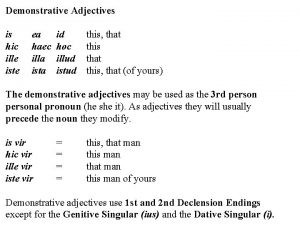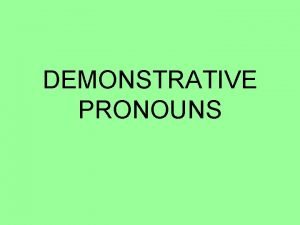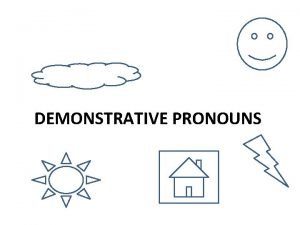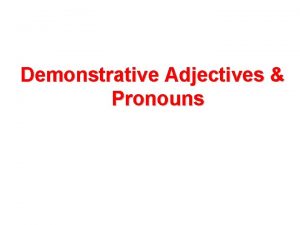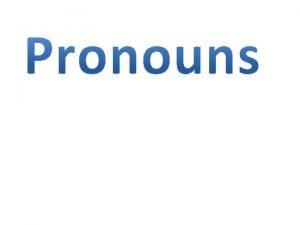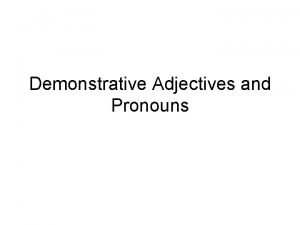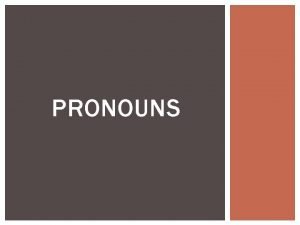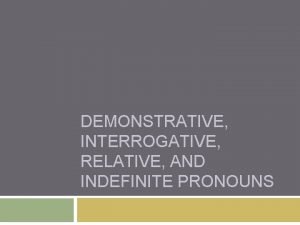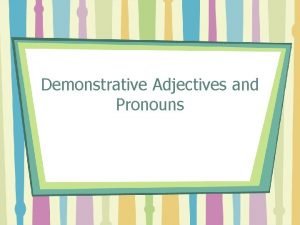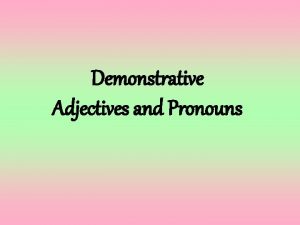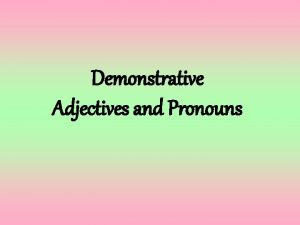HIC ILLE ISTE Demonstrative Pronouns Adjectives A pronoun





![If it is an adjective…. [most common usage] Since adjectives modify nouns, if it If it is an adjective…. [most common usage] Since adjectives modify nouns, if it](https://slidetodoc.com/presentation_image_h2/87d57435a140ba82c85fed28700a9f1d/image-6.jpg)




- Slides: 10

HIC & ILLE & ISTE Demonstrative Pronouns & Adjectives

• A pronoun is a word used in place of a noun or another pronoun.

A demonstrative is used to single out one or more nouns referred to in the sentence. This, that, these, and those are demonstratives. These mountains are high. The word "these" is a demonstrative adjective because it is modifying “mountains”.

Pronoun vs. Adjectives • Hic and ille can be either a pronoun or adjective – how do I tell the difference? – Keep the grammatical usage in mind • If the form of hic or ille modifies a noun, it is an adjective – For example: hic poeta = this poet • If the form of hic or ille stands alone, it is a pronoun – For example: Ubi est ille? = Where is that [man]? – N. B. Since ille is masculine gender, you can assume it means “that man”, but since the word “vir is understood, ille is a pronoun.

Why do I care if it is a pronoun or adjective? so you will can determine: • case • number • gender
![If it is an adjective most common usage Since adjectives modify nouns if it If it is an adjective…. [most common usage] Since adjectives modify nouns, if it](https://slidetodoc.com/presentation_image_h2/87d57435a140ba82c85fed28700a9f1d/image-6.jpg)
If it is an adjective…. [most common usage] Since adjectives modify nouns, if it is an adjective, it will agree with the noun it modifies. example: I see that girl. Puellam illam video. “That” modifies “girl” which is a direct object = acc. s. f. so the adjective will also be acc. s. f.

If it is a pronoun…. …the demonstrative can usually be translated according to its gender, number, and context. Example: ille = that man illa = that woman illud = that thing

M Singular Nom. Gen. Dat. Acc. Abl. Plural Nom. Gen. Dat. Acc. Abl. F N HIC HUIUS HAEC HUIUS HOC HUIUS HUIC HUNC HŌC HUIC HANC HAC HUIC HOC HŌC HI HORUM HIS HOS HIS HAE HARUM HIS HAS HIS HAEC HORUM HIS HAEC HIS Hic, Haec, Hoc This = sing. These – pl. The plural endings = 1 st and 2 nd declension noun endings – you know them!

M Singular Nom. Gen. Dat. Acc. Abl. Plural Nom. Gen. Dat. Acc. Abl. F N ILLE ILLIUS ILLA ILLIUS ILLUD ILLIUS ILLI ILLUM ILLO ILLI ILLAM ILLA ILLI ILLUD ILLO ILLI ILLAE ILLA ILLORUM ILLARUM ILLORUM ILLIS ILLOS ILLA ILLIS Ille, Illa, Illud That = sing. Those – pl. The plural endings = 1 st and 2 nd declension noun endings – you know them!

M F N Singular Nom. Gen. ISTE ISTIUS ISTA ISTIUS ISTUD ISTIUS Dat. Acc. ISTI ISTUM ISTI ISTAM ISTI ISTUD ISTO ISTA ISTO Abl. Plural Nom. Gen. Dat. Acc. Abl. ISTI ISTAE ISTA ISTORUM ISTARUM ISTORUM ISTIS ISTOS ISTA ISTIS Iste, Ista, Istud That = sing. [near you] Those– pl. [near you] The plural endings = 1 st and 2 nd declension noun endings – you know them!
